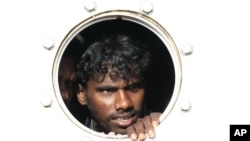SYDNEY —
The United Nations has released a highly critical report of Australia's offshore immigration detention center at Manus Island in Papua New Guinea. The United Nations High Commissioner for Refugees is calling for an end to Canberra’s policy of automatically detaining asylum seekers.
The Australian-run immigration facility in Papua New Guinea was reopened at the end of last year to stop a steady flow of asylum seekers reaching Australia by boat.
Representatives of the United Nations High Commissioner for Refugees spent three days studying the Manus Island facility in January. Their report criticizes the cramped conditions inside the camp, stressing that the isolated facility was potentially damaging for children.
The United Nations opposes offshore detention. Richard Towle, the UNHCR's regional representative says that among other things, it is difficult to meet international standards in remote parts of the South Pacific.
“The key failing is that there are in place no legal frameworks for the processing of refugee claims," says Towle. "If the sole purpose of transfer from Australia to Papua New Guinea was to process people, one would expect there'd be some kind of process in place for people when they get there. These 221 people are being held in mandatory closed and indefinite detention, which is a very serious violation of international law.”
Refugee advocates say the Manus Island center houses around 250 asylum seekers, including more than 30 children. Approximately one-half are families from Sri Lanka, while others have come from Iran, Iraq and Afghanistan.
Rights groups have also condemned conditions at another Australian-sponsored camp on the tiny Pacific island of Nauru.
Following an inspection in December, Amnesty International said it had found what it called “a toxic mix of uncertainty, unlawful detention and inhumane conditions” that were creating an “increasingly volatile situation.”
The Australian government has said it will continue to improve facilities at its centers on Nauru and Manus Island.
Ministers insist the offshore camps are deterring asylum seekers from making the perilous sea voyage to Australia. The alternative is to expand existing facilities on the mainland or build new camps, which the government is keen to avoid in an election year.
Immigration is likely to be a divisive issue when the country goes to the polls in September. Conservative critics of the Labor government accuse it of losing control of Australia’s maritime borders, while the Green Party, which is allied with the Labor government, says that Canberra’s treatment of vulnerable asylum seekers is inhumane.
Australia grants protection visas to about 13,000 refugees each year under various international treaties.
The Australian-run immigration facility in Papua New Guinea was reopened at the end of last year to stop a steady flow of asylum seekers reaching Australia by boat.
Representatives of the United Nations High Commissioner for Refugees spent three days studying the Manus Island facility in January. Their report criticizes the cramped conditions inside the camp, stressing that the isolated facility was potentially damaging for children.
The United Nations opposes offshore detention. Richard Towle, the UNHCR's regional representative says that among other things, it is difficult to meet international standards in remote parts of the South Pacific.
“The key failing is that there are in place no legal frameworks for the processing of refugee claims," says Towle. "If the sole purpose of transfer from Australia to Papua New Guinea was to process people, one would expect there'd be some kind of process in place for people when they get there. These 221 people are being held in mandatory closed and indefinite detention, which is a very serious violation of international law.”
Refugee advocates say the Manus Island center houses around 250 asylum seekers, including more than 30 children. Approximately one-half are families from Sri Lanka, while others have come from Iran, Iraq and Afghanistan.
Rights groups have also condemned conditions at another Australian-sponsored camp on the tiny Pacific island of Nauru.
Following an inspection in December, Amnesty International said it had found what it called “a toxic mix of uncertainty, unlawful detention and inhumane conditions” that were creating an “increasingly volatile situation.”
The Australian government has said it will continue to improve facilities at its centers on Nauru and Manus Island.
Ministers insist the offshore camps are deterring asylum seekers from making the perilous sea voyage to Australia. The alternative is to expand existing facilities on the mainland or build new camps, which the government is keen to avoid in an election year.
Immigration is likely to be a divisive issue when the country goes to the polls in September. Conservative critics of the Labor government accuse it of losing control of Australia’s maritime borders, while the Green Party, which is allied with the Labor government, says that Canberra’s treatment of vulnerable asylum seekers is inhumane.
Australia grants protection visas to about 13,000 refugees each year under various international treaties.





